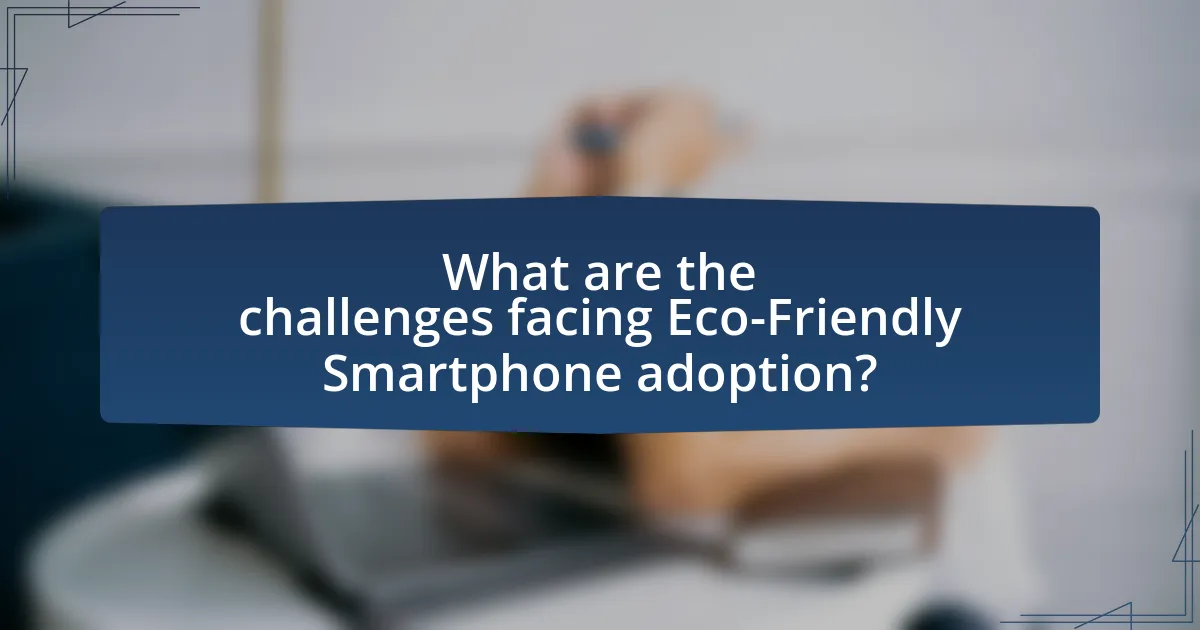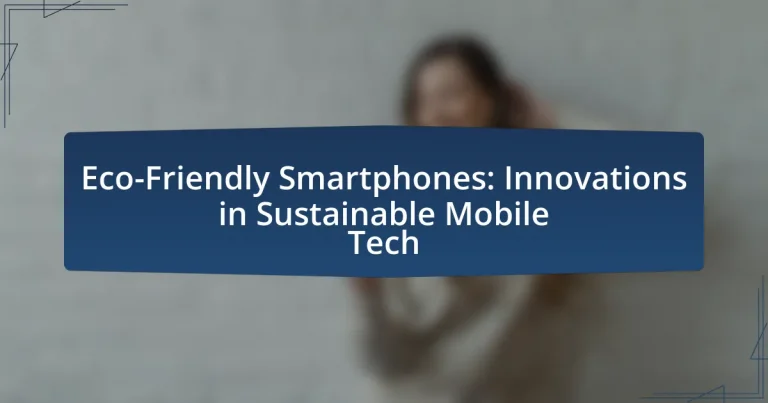Eco-friendly smartphones are mobile devices designed with sustainable materials and practices to reduce environmental impact. This article explores the differences between eco-friendly and traditional smartphones, highlighting the use of recycled materials, energy-efficient manufacturing processes, and modular designs that promote longevity and repairability. It also addresses the importance of sustainability in the smartphone industry, the environmental impacts of traditional production, and the innovations driving eco-friendly technology. Additionally, the article discusses the challenges facing adoption, consumer misconceptions, and best practices for identifying and maximizing the lifespan of eco-friendly smartphones.

What are Eco-Friendly Smartphones?
Eco-friendly smartphones are mobile devices designed with sustainable materials and practices to minimize environmental impact. These smartphones often utilize recycled materials in their construction, such as aluminum and plastics, and are manufactured using energy-efficient processes. Additionally, eco-friendly smartphones may feature modular designs that allow for easy repairs and upgrades, reducing electronic waste. According to a report by the Global System for Mobile Communications (GSMA), the mobile industry is responsible for about 4% of global greenhouse gas emissions, highlighting the importance of adopting eco-friendly practices in smartphone production to mitigate climate change.
How do Eco-Friendly Smartphones differ from traditional smartphones?
Eco-friendly smartphones differ from traditional smartphones primarily in their materials and manufacturing processes. Eco-friendly smartphones utilize sustainable materials such as recycled metals and bioplastics, reducing environmental impact, while traditional smartphones often rely on virgin materials that contribute to resource depletion. Additionally, eco-friendly models are designed for longevity and repairability, promoting a circular economy, whereas traditional smartphones frequently prioritize short product lifespans and planned obsolescence. This distinction is supported by the fact that companies like Fairphone have demonstrated that sustainable practices can lead to reduced electronic waste and lower carbon footprints compared to conventional smartphone production methods.
What materials are used in the production of Eco-Friendly Smartphones?
Eco-friendly smartphones are produced using sustainable materials such as recycled metals, bioplastics, and responsibly sourced minerals. These materials include aluminum and copper sourced from recycled electronic waste, which reduces the need for new mining and lowers environmental impact. Additionally, bioplastics derived from renewable resources like corn starch are used for casings, while glass made from recycled content is often utilized for screens. The use of these materials not only minimizes waste but also promotes a circular economy in the tech industry.
How does the design of Eco-Friendly Smartphones promote sustainability?
The design of Eco-Friendly Smartphones promotes sustainability by utilizing recyclable materials and energy-efficient manufacturing processes. These smartphones often incorporate biodegradable plastics, recycled metals, and sustainable sourcing of raw materials, which reduces environmental impact. For instance, a study by the Global System for Mobile Communications Association (GSMA) indicates that using recycled materials can significantly lower carbon emissions associated with production. Additionally, eco-friendly designs prioritize modular components, allowing for easier repairs and upgrades, which extends the device’s lifespan and reduces electronic waste. This approach aligns with the principles of a circular economy, where products are designed for longevity and recyclability, further enhancing sustainability efforts in the tech industry.
Why is sustainability important in the smartphone industry?
Sustainability is important in the smartphone industry because it addresses environmental concerns associated with resource extraction, manufacturing, and electronic waste. The smartphone industry is responsible for significant carbon emissions, with estimates suggesting that the production of a single smartphone generates approximately 55 to 95 kilograms of CO2. Additionally, the improper disposal of smartphones contributes to the growing problem of electronic waste, which is projected to reach 74 million metric tons globally by 2030. By prioritizing sustainable practices, such as using recycled materials and reducing energy consumption, the industry can mitigate its environmental impact and promote a circular economy.
What environmental impacts are associated with traditional smartphone production?
Traditional smartphone production is associated with significant environmental impacts, including resource depletion, pollution, and electronic waste. The extraction of raw materials such as lithium, cobalt, and rare earth metals leads to habitat destruction and water pollution. For instance, mining activities can result in soil erosion and contamination of local water sources, affecting ecosystems and communities. Additionally, the manufacturing process emits greenhouse gases and toxic substances, contributing to air and water pollution. According to a study by the United Nations University, approximately 50 million tons of electronic waste are generated globally each year, with smartphones being a major contributor. This waste often ends up in landfills, where hazardous materials can leach into the environment, posing risks to human health and biodiversity.
How do Eco-Friendly Smartphones contribute to reducing electronic waste?
Eco-friendly smartphones contribute to reducing electronic waste by utilizing sustainable materials and promoting longer product lifespans. These devices often incorporate recyclable components, such as aluminum and biodegradable plastics, which minimize the environmental impact when discarded. Additionally, manufacturers of eco-friendly smartphones frequently design their products for easy repair and upgrade, encouraging users to maintain their devices longer rather than replacing them. For instance, a study by the Global E-waste Monitor reported that extending the lifespan of smartphones by just one year could significantly reduce e-waste generation, highlighting the effectiveness of sustainable design practices in mitigating electronic waste.

What innovations are driving Eco-Friendly Smartphone technology?
Innovations driving eco-friendly smartphone technology include the use of biodegradable materials, energy-efficient manufacturing processes, and enhanced recycling programs. Biodegradable materials, such as bioplastics and recycled metals, reduce environmental impact by minimizing waste. Energy-efficient manufacturing processes, which often utilize renewable energy sources, lower carbon emissions during production. Enhanced recycling programs, like take-back initiatives, ensure that smartphones are properly disposed of and materials are reused, contributing to a circular economy. These innovations collectively aim to reduce the ecological footprint of smartphones while promoting sustainability in the tech industry.
How are manufacturers incorporating renewable materials into smartphone design?
Manufacturers are incorporating renewable materials into smartphone design by utilizing bioplastics, recycled metals, and sustainably sourced materials. For instance, companies like Apple and Samsung have begun using bioplastics derived from plant materials for components such as casings and internal parts. Apple reported that it has increased the use of recycled aluminum in its products, achieving over 75% recycled content in some models. Additionally, brands are sourcing materials like bamboo and recycled ocean plastics to create more sustainable devices. This shift not only reduces reliance on fossil fuels but also minimizes waste, aligning with global sustainability goals.
What are the benefits of using biodegradable materials in smartphones?
The benefits of using biodegradable materials in smartphones include reduced environmental impact, enhanced sustainability, and improved consumer appeal. Biodegradable materials decompose naturally, minimizing landfill waste and pollution associated with traditional plastics, which can take hundreds of years to break down. For instance, a study published in the journal “Environmental Science & Technology” highlights that using biodegradable polymers can significantly lower carbon emissions during production and disposal compared to conventional materials. Additionally, consumers increasingly prefer eco-friendly products, leading to a competitive advantage for manufacturers who adopt biodegradable materials in their smartphone designs.
How does the use of recycled materials impact smartphone performance?
The use of recycled materials in smartphones can impact performance positively by enhancing thermal conductivity and reducing weight. Recycled metals, such as aluminum and copper, often exhibit similar or improved properties compared to their virgin counterparts, which can lead to better heat dissipation and overall efficiency. For instance, a study by the International Journal of Environmental Research and Public Health found that using recycled aluminum can reduce energy consumption in manufacturing by up to 95%, indirectly benefiting performance by allowing for more efficient energy use in devices. Additionally, the integration of recycled plastics can contribute to a lighter device, which may enhance user experience without compromising structural integrity.
What role does energy efficiency play in Eco-Friendly Smartphones?
Energy efficiency is crucial in eco-friendly smartphones as it reduces energy consumption and minimizes environmental impact. By utilizing energy-efficient components, such as processors and displays, these smartphones can operate effectively while consuming less power, which leads to longer battery life and reduced reliance on frequent charging. For instance, energy-efficient smartphones can use up to 30% less energy compared to traditional models, significantly lowering carbon emissions associated with electricity generation. This efficiency not only conserves resources but also aligns with global sustainability goals, making energy efficiency a key factor in the development and appeal of eco-friendly smartphones.
How do Eco-Friendly Smartphones achieve better energy efficiency?
Eco-friendly smartphones achieve better energy efficiency through the use of sustainable materials, energy-efficient components, and optimized software. These devices often incorporate renewable materials like recycled metals and bioplastics, which reduce the energy required for production. Additionally, energy-efficient components such as low-power processors and OLED displays consume less power during operation. Optimized software, including power management systems, further enhances energy efficiency by minimizing battery drain. For instance, studies show that OLED displays can save up to 30% more energy compared to traditional LCDs when displaying darker images, reinforcing the effectiveness of these technologies in eco-friendly smartphones.
What are the implications of energy-efficient smartphones for consumers?
Energy-efficient smartphones significantly reduce electricity consumption for consumers, leading to lower utility bills and a smaller carbon footprint. These devices typically utilize advanced technologies, such as optimized processors and energy-saving displays, which enhance battery life and performance. For instance, a study by the International Energy Agency indicates that energy-efficient smartphones can save users up to 30% on energy costs compared to traditional models. Additionally, consumers benefit from longer device longevity, as energy-efficient designs often result in less heat generation, reducing wear and tear on components. This combination of cost savings and environmental benefits makes energy-efficient smartphones a compelling choice for consumers.

What are the challenges facing Eco-Friendly Smartphone adoption?
The challenges facing eco-friendly smartphone adoption include high production costs, limited consumer awareness, and inadequate recycling infrastructure. High production costs arise from the use of sustainable materials and technologies, making eco-friendly smartphones more expensive than conventional models. Limited consumer awareness hampers adoption, as many potential buyers are unaware of the benefits and availability of eco-friendly options. Additionally, inadequate recycling infrastructure complicates the disposal of old devices, discouraging consumers from switching to sustainable alternatives. These factors collectively hinder the widespread acceptance of eco-friendly smartphones in the market.
What barriers exist for consumers in choosing Eco-Friendly Smartphones?
Consumers face several barriers when choosing eco-friendly smartphones, primarily including higher costs, limited availability, and lack of awareness. The higher price point of eco-friendly smartphones often deters consumers who may prioritize affordability over sustainability. Additionally, eco-friendly options are frequently less available in mainstream markets, making it challenging for consumers to find these devices. Furthermore, many consumers lack awareness of the environmental impact of their smartphone choices, leading to a preference for conventional models. According to a 2021 survey by the International Telecommunication Union, only 30% of consumers considered sustainability when purchasing electronics, highlighting the need for increased education and marketing around eco-friendly smartphones.
How does pricing affect the adoption of Eco-Friendly Smartphones?
Pricing significantly influences the adoption of eco-friendly smartphones, as higher prices often deter consumers from purchasing these devices. Research indicates that consumers are generally price-sensitive, and when eco-friendly smartphones are priced above traditional models, adoption rates decline. For instance, a study by the International Journal of Consumer Studies found that 70% of consumers are less likely to buy eco-friendly products if they perceive them as too expensive compared to conventional alternatives. This price barrier can limit market penetration and slow the transition to sustainable technology.
What misconceptions do consumers have about Eco-Friendly Smartphones?
Consumers often believe that eco-friendly smartphones are significantly less powerful or feature-rich than traditional smartphones. This misconception arises from the assumption that sustainable materials and practices compromise performance. However, many eco-friendly smartphones, such as those from brands like Fairphone and Apple, incorporate advanced technology and high-performance specifications while utilizing recycled materials and ethical manufacturing processes. Research indicates that eco-friendly smartphones can match or exceed the capabilities of their conventional counterparts, demonstrating that sustainability does not equate to inferior quality.
How can manufacturers overcome challenges in producing Eco-Friendly Smartphones?
Manufacturers can overcome challenges in producing eco-friendly smartphones by adopting sustainable materials, implementing efficient recycling processes, and investing in renewable energy for production. Utilizing biodegradable plastics and recycled metals reduces environmental impact, as evidenced by companies like Fairphone, which sources conflict-free minerals and promotes modular designs for easier repairs. Additionally, integrating closed-loop recycling systems allows manufacturers to reclaim materials from old devices, thereby minimizing waste. Research from the Global System for Mobile Communications Association indicates that transitioning to renewable energy in manufacturing can reduce carbon emissions by up to 80%. These strategies collectively enhance sustainability in smartphone production.
What strategies can be implemented to reduce production costs?
To reduce production costs in the manufacturing of eco-friendly smartphones, companies can implement strategies such as optimizing supply chain management, utilizing sustainable materials, and investing in automation technologies. Optimizing supply chain management can lead to reduced logistics costs and improved efficiency, as evidenced by a study from the Council of Supply Chain Management Professionals, which found that effective supply chain practices can lower costs by up to 15%. Utilizing sustainable materials, such as recycled plastics and metals, not only reduces material costs but also appeals to environmentally conscious consumers, enhancing brand value. Additionally, investing in automation technologies can streamline production processes, reduce labor costs, and increase output, with research from McKinsey indicating that automation can improve productivity by 20-25% in manufacturing sectors.
How can collaboration within the industry enhance sustainability efforts?
Collaboration within the industry can enhance sustainability efforts by enabling the sharing of best practices, resources, and technologies among companies. When smartphone manufacturers, suppliers, and stakeholders work together, they can develop more efficient production processes, reduce waste, and promote the use of sustainable materials. For instance, the Global Electronics Council’s initiatives have shown that collaborative efforts can lead to the adoption of eco-labeling standards, which help consumers make informed choices and encourage manufacturers to prioritize sustainability. Additionally, partnerships can facilitate research and development of innovative recycling technologies, as seen in the collaboration between Apple and its suppliers to improve the recyclability of materials used in smartphones.
What are the best practices for consumers when choosing Eco-Friendly Smartphones?
Consumers should prioritize smartphones with sustainable materials, energy-efficient designs, and ethical manufacturing practices when choosing eco-friendly options. Selecting devices made from recycled or biodegradable materials reduces environmental impact, while energy-efficient models minimize electricity consumption. Additionally, supporting brands that adhere to fair labor practices and have transparent supply chains ensures ethical production. Research indicates that smartphones contribute significantly to electronic waste, with over 50 million tons generated annually, highlighting the importance of making informed choices that promote sustainability.
How can consumers identify truly Eco-Friendly Smartphones?
Consumers can identify truly eco-friendly smartphones by looking for certifications such as Energy Star, EPEAT, and TCO Certified, which indicate adherence to environmental standards. Additionally, examining the materials used in the smartphone, such as recycled metals and plastics, can provide insight into its sustainability. Research shows that smartphones with a high percentage of recycled content significantly reduce environmental impact; for instance, Apple reported that its iPhone 12 models used 99% recycled aluminum in their enclosures. Furthermore, consumers should consider the manufacturer’s commitment to sustainability practices, including responsible sourcing of materials and recycling programs, as companies like Fairphone actively promote ethical production and repairability.
What tips can help consumers maximize the lifespan of their Eco-Friendly Smartphones?
To maximize the lifespan of Eco-Friendly Smartphones, consumers should adopt practices such as using protective cases, avoiding extreme temperatures, and regularly updating software. Protective cases can prevent physical damage, which is crucial since Eco-Friendly Smartphones often use sustainable materials that may be less durable than traditional ones. Avoiding extreme temperatures helps maintain battery health, as lithium-ion batteries can degrade faster in high heat or extreme cold. Regular software updates ensure that the device runs efficiently and securely, prolonging its usability. These practices are supported by studies indicating that proper care can extend the lifespan of electronic devices significantly, with some estimates suggesting up to 50% longer usage when maintained correctly.





